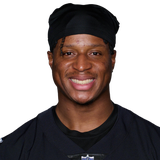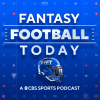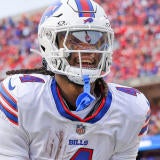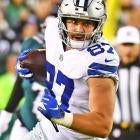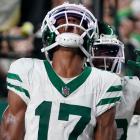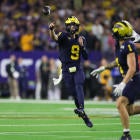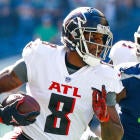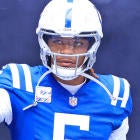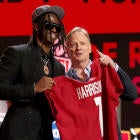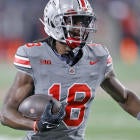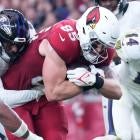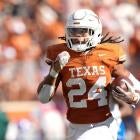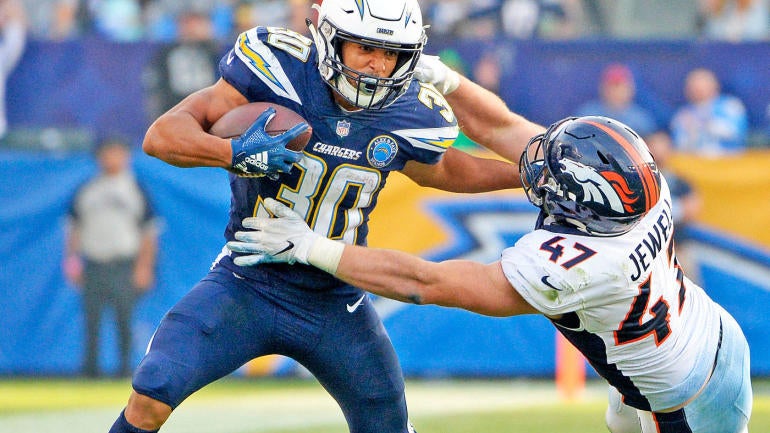
In PPR Fantasy football formats, there is a clear formula to identifying running back upside — receptions plus goal-line work. It really is that simple. Any back who catches a lot of passes and has touchdown potential has a far easier path to upside than one who doesn't.
Consider that for his absolutely Herculean effort last year, Derrick Henry's 20.0 PPR points per game were 0.4 more than a back who rushed for 557 yards in Austin Ekeler. Henry was the platonic ideal of a bruising, early-down back; Ekeler was right there with him despite spending the majority of the season in a committee. Both were highly efficient players, but it was Ekeler who had even more upside because had he gotten extended run as the lead back, he arguably could have crushed Henry's Fantasy total.
And that was despite Henry being an outlier. In 2019, with his 18 receptions, Henry became the first full-season top-five PPR back with fewer than 40 catches since Ezekiel Elliott in 2016, and the first with fewer than 30 catches since Marshawn Lynch in 2012. Lynch and Henry are the only two who have done that in the past 10 seasons, making 48 of 50 backs to have finished as a top-five PPR back over the past 10 years who had at least 30 receptions.
That is to say, we shouldn't chase the next Henry, a back who thrives on elite rushing efficiency that is hard to sustain over a full season. Of the 19 NFL backs who had at least 250 touches in 2019, six had 25 or fewer receptions. The other five in that group — Josh Jacobs, Marlon Mack, David Montgomery, Carlos Hyde and Sony Michel — all finished outside the top 20 PPR backs.
No, instead, we should chase the next Ekeler. This is the basis for the high-value touch (HVT) and TRAP stats I introduced last summer and have written about for much of the past year. High-value touches constitute all receptions anywhere on the field plus all touches inside the 10-yard line, which I will refer to as the green zone. About a quarter of all RB touches come from these two groups, but they account for nearly 60% of RB Fantasy points.
Ekeler's 103 HVT in 2019 made him the only back other than Christian McCaffrey to total at least 100 of those touches. And that was predictable in his range of outcomes, largely because of his offense. The Chargers consistently generated plenty of HVT for their backs, which explained Ekeler's massive upside when Melvin Gordon held out and is the chief reason I compared him to Alvin Kamara after Gordon had returned in-season. A major basis of that comparison, which seemed to fly against the grain of how significant of an impact Gordon's return would have on Ekeler's value, was the similarity between the Chargers and Saints in terms of consistently lofty HVT production for their entire backfields.
I'm not trying to toot my own horn here as much as I'm trying to emphasize thinking in this way leads to actionable conclusions about RB upside before the market, and utilizing this stat I introduced last offseason served me well in my own leagues.
One of the most actionable ways I have looked at HVT is through a team lens. Last year, in talking about which offenses had HVT upside for their backs, I threw out five bulleted conclusions that were all fairly accurate. That piece noted Miami was a poor situation for RB scoring, argued Le'Veon Bell would have a hard time approaching his prior Fantasy potential with the Steelers after joining the Jets, said both the Saints and Raiders backfields presented big handcuff upside (as Latavius Murray and DeAndre Washington subsequently demonstrated), and argued against Todd Gurley's upside.
| ||||||||||
Not all of those points were perfectly applicable, and I notably got the Raiders backup wrong (targeting Jalen Richard instead) and used my Miami conclusion to fade Kenyan Drake, who of course went on to thrive after a midseason trade to Arizona. But there were several actionable takeaways about backs to fade, backfields to target, and important team-level considerations when drafting your Fantasy team.
So of course, I wanted to dig into the same concepts for 2020. The crux of last year's piece was that not all running back committees are alike, with the central section of that piece being titled, "Rethinking the word 'committee'". The point was that committee backs can be highly valuable for Fantasy if their team generates a ton of high-value touches. Collectively, we tend to think in terms of whether a back is a bell cow in his offense or not, and Average Draft Positions and general RB discussions tend to reflect that. But the second part of the puzzle that goes underappreciated and is more exploitable is the value of the offense.
It explained the Ekeler explosion, and why he retained so much value even after Gordon returned. It explained why a committee backfield in a situation like Miami was an avoid on all fronts. And it even explained the relative value of projected bell-cow backs.
Let's dig into how each team's 2019 looked in terms of HVT, how that compared to each team's recent seasons, and some key actionable takeaways for 2020.
Chargers changes
Let's hit on the Chargers first, because their HVT total in 2019 tops the charts for any team from the past four seasons. That was certainly an upside outcome, driven largely by Ekeler's expanded role. A key point I made in last year's column is that these team totals are impacted by the players within them (see: McCaffrey's impact on the Panthers after being drafted in 2017).
It's not just the running backs, either — one of the big reasons team HVT potential is so exploitable despite its perceived instability year over year is mobile quarterbacks tend to throw to backs at a lower rate than immobile ones. Mobile quarterbacks extend plays with their legs; immobile ones check down quicker.
The shift from Rivers to Tyrod Taylor could not be more drastic in terms of immobility to mobility, and while Taylor did target LeSean McCoy a decent amount while starting for the Bills, McCoy's peak target season with Taylor (77 in 2017, after 50 and 57 in 2015 and 2016) came after Sammy Watkins and Robert Woods left and the Bills' most-targeted downfield weapons were Charles Clay, Zay Jones and Deonte Thompson.
That is to say, Ekeler is in line for a substantial drop-off from the 108 targets he saw last year, both because the Chargers will throw far fewer passes overall with Taylor under center, and because the Chargers have way better downfield weapons than Taylor's past teams had. I would be all over Ekeler in the second round if Rivers were still with the Chargers, but he's not a key early-round target for me given the offensive changes.
Colts set to rise under Rivers
Of course, if I believe Rivers played a big role in strong team HVT numbers throughout his time with the Chargers, I'm optimistic about the Colts. With Jacoby Brissett under center, the Colts were in the bottom half of the league in HVT. But in 2018, with Andrew Luck and in Frank Reich's first year with the team, they finished sixth.
I think Rivers means that HVT total will catapult back up near the top of the league in 2020, which is great news for passing downs back Nyheim Hines but also explains why I think either/both of Jonathan Taylor and Marlon Mack can catch more passes than expected even if they only play on early downs. Taylor interestingly caught far more passes at Wisconsin than Melvin Gordon did in his time as a Badger, but Gordon caught at least 30 balls in each of five seasons playing with Rivers, averaging 45 per season despite the combination of Danny Woodhead and Ekeler combining for more receptions across those years.
And much like Gordon and other collegiate backs in great rushing offenses, Taylor may have not been used in the passing game at Wisconsin simply because it wasn't necessary. Supporting this is the fact that Taylor's receiving tended to tick up when his rushing efficiency lagged, which wasn't often. Taylor failed to rush for at least 5.0 yards per carry in just 11 of 41 career games. In seven of those 11 games, he caught multiple passes. He only caught multiple passes five times in his other 30 career games. When you add in that Taylor averaged 9.7 yards per reception for his career and scored five receiving touchdowns on 42 college catches, there's a solid case to be made he can follow Gordon's path of developing more receiving production than expected at the next level.
Some quick(er) hits
- The gap between New Orleans and Dallas helps explain why I prefer Alvin Kamara to Ezekiel Elliott in PPR. Kamara has always generated a high rate of HVT, but his role had expanded in 2019 before his high-ankle sprain. Statistically, Kamara is the closest thing to McCaffrey among the elite backs, and while he doesn't have the same ceiling, it would not be a surprise to see him hit either 200 carries or 100 catches for the first time in 2020. If he hits both, wheels up.
- The Eagles are a perfect example of a team that has jumped around based on RB personnel. High in the Team HVT leaderboard in 2016 when Darren Sproles was last healthy, they finished in the bottom half in both 2017 and 2018 before a resurgence in 2019. A key note from Miles Sanders' 2019 is that even before his explosion, his receiving role was fairly consistent. Sanders had multiple catches in 15 of 17 games, playoffs included, and even in a four-game October stretch where he failed to crest double-digit carries in any game and averaged just 5.3 carries per game, Sanders caught at least three passes each week. This a great indication for Sanders' potential upside, and is why I was calling him a buy early in the season. Then there's Boston Scott, who I named as one of my favorite sleeper running backs for 2020 Tuesday. Scott's an obvious late-round PPR target and the best bet to have an Ekeler-like impact in 2020.
- New England has consistently been among the league leaders, but despite how much Cam Newton clearly embraced McCaffrey late in his Carolina tenure, I'm skeptical the Patriots will generate as many HVT now that Tom Brady is gone. But James White -- always the key target here for HVT -- is priced very reasonably in PPR formats.
- San Francisco stands out as a team that saw the related bump in overall running back touches that comes with winning, but didn't finish very high in total HVT. I would never fade a Kyle Shanahan backfield, but I'm more interested in the cheaper options here than Raheem Mostert, who got his new deal but still only caught 17 balls in 2019, including the postseason. Part of that is related to how the 49ers use Kyle Juszczyk, and with Jordan Reed now added to the short-area target mix and obviously George Kittle, this is an offense that could regress, lose some RB touches and still not throw to the backs much. There still should be plenty of touchdown potential, though.
- On the opposite end of the spectrum from San Francisco, the Cardinals were last in the league in total RB touches, but generated a high rate of HVT (far right column) and had plenty of RB Fantasy production throughout 2019 from different backs. I have Kenyan Drake one spot ahead of Ekeler in PPR formats, and think his upside might be higher. I'm also targeting Chase Edmonds and even Eno Benjamin in deeper formats. All three backs have solid receiving potential in their profiles, and despite Murray's mobility, there could be plenty of RB targets because the Cardinals could be a very pass-heavy team.
- I'm optimistic about Tarik Cohen. He's dominated receiving work for a Bears offense that has solid HVT totals under Matt Nagy, and David Montgomery struggled in the green zone in 2019 in a way that could lead to more creative play-calling in close in 2019. Add in that any Nick Foles time under center means a less mobile quarterback who could throw to his backs more, and there's a path for Cohen to hit the type of passing downs specialist upside that has propelled the likes of James White, Danny Woodhead and Darren Sproles to top-10 PPR seasons.







